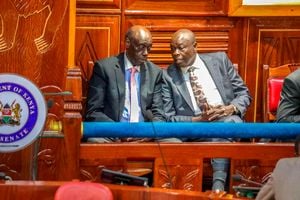Counties blamed for low uptake of power

Energy Minister says the devolved units failed to invest in “mega-industries” which they had hyped in 2013 at the advent of devolution. PHOTO | FILE
What you need to know:
- In 2013, the government targeted to add 5,000 megawatts to the then existing 1,750 megawatts.
- The country’s total power capacity has grown to only about 2,400 megawatts over the period.
- Save for the standard gauge railway, which is expected to go live in June, other Vision 2030 projects have delayed, including the Konza technopolis.
The Energy Ministry is now accusing counties of not creating adequate demand for the envisioned power production target.
Cabinet Secretary Charles Keter says this is the reason the government has failed to triple the generation capacity as promised four years ago.
In 2013, the government targeted to add 5,000 megawatts to the then existing 1,750 megawatts.
But the country’s total power capacity has grown to only about 2,400 megawatts over the period.
Mr Keter says the devolved units failed to invest in “mega-industries” which they had hyped in 2013 at the advent of devolution.
“When devolution set in, we expected many things to happen, including creation of new industries. We expected that institutions would consume an upwards of 5,000MW. We were prepared to give them power, but we were slowed down by lack of demand,” Mr Keter told the Sunday Nation in an interview.
Since power cannot be stored, the minister said, excess capacity would be a burden to consumers.
Save for the standard gauge railway, which is expected to go live in June, other Vision 2030 projects have delayed, including the Konza technopolis.
Mr Keter said the country currently produces more than it consumes, since most users are households that need minimal power.
Industries should be the prime consumers.
Peak demand is currently at 1,620 megawatts, against the country’s total capacity of 2,400 megawatts.
“If we were to produce 5,000MW, the power would be idle yet the citizens would shoulder the cost of loans by investors,” said the Cabinet Secretary.
Export electricity
He said the ministry was planning to produce electricity for export to other East African countries once they surmount the problems that come with transmission of high voltage power.
“Power can be exported to Uganda, Burundi and Tanzania. But we have a challenge of transmitting high voltage power. The major problem is that people do not give us wayleaves through their land,” said Mr Keter.
He said they were closely monitoring growth in marked areas as industrial parks to ensure their demand for power is met.
Meanwhile, Nyanza and Western regions will soon start receiving energy from Olkaria geothermal plant, a move that will enhance quality and end outages that affect the zone.
The project by the Kenya Electricity Transmission Company (Ketraco) consists of a power line from Olkaria to Lessos and then to Kisumu’s Mamboleo station, with a capacity of between 70 and 80 megawatts, depending on demand.
According to Ketraco engineer Samson Akuto, Western Kenya currently relies on Sondu and Turkwel generating centres, which are both weather dependent, hence unreliable.
“Kisumu receives 40-50 megawatts, which is not only insufficient but also unreliable and poor quality,” he said.




